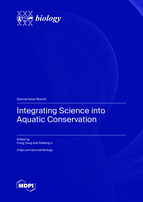Integrating Science into Aquatic Conservation
A special issue of Biology (ISSN 2079-7737). This special issue belongs to the section "Zoology".
Deadline for manuscript submissions: closed (31 August 2023) | Viewed by 22955
Special Issue Editors
Interests: marine conservation; aquatic animals; integrating ecology; evolution; genetics; spatial analysis
Special Issues, Collections and Topics in MDPI journals
Special Issue Information
Dear Colleagues,
As a crucial component of the hydrosphere, aquatic ecosystems have always been essential support for human survival and development. However, since the last century, under the combined pressure of human activities and climate change, many aquatic organisms have been greatly threatened, and aquatic biodiversity has shown a declining trend. The development of effective conservation is expected to mitigate or avoid these negative impacts. However, biological conservation is a complex and systematic project that involves research findings from multiple disciplines and therefore requires the design of conservation strategies from multiple perspectives. Thus, this Topic will include articles related to aquatic conservation, including but not limited to studies on aquatic populations, aquatic communities, aquatic ecosystems, and aquatic conservation management. The findings are expected to provide direct conservation recommendations or implications for better protection of aquatic animals and ecosystems. Papers may focus on aquatic biodiversity, genetic differentiation of populations, connectivity among populations, spatial variation in communities, ecosystem function, and tracking of the effectiveness of protected area management. We seek papers that cover a variety of spatial scales, from local to global.
Dr. Cong Zeng
Prof. Dr. Deliang Li
Guest Editors
Manuscript Submission Information
Manuscripts should be submitted online at www.mdpi.com by registering and logging in to this website. Once you are registered, click here to go to the submission form. Manuscripts can be submitted until the deadline. All submissions that pass pre-check are peer-reviewed. Accepted papers will be published continuously in the journal (as soon as accepted) and will be listed together on the special issue website. Research articles, review articles as well as short communications are invited. For planned papers, a title and short abstract (about 100 words) can be sent to the Editorial Office for announcement on this website.
Submitted manuscripts should not have been published previously, nor be under consideration for publication elsewhere (except conference proceedings papers). All manuscripts are thoroughly refereed through a single-blind peer-review process. A guide for authors and other relevant information for submission of manuscripts is available on the Instructions for Authors page. Biology is an international peer-reviewed open access monthly journal published by MDPI.
Please visit the Instructions for Authors page before submitting a manuscript. The Article Processing Charge (APC) for publication in this open access journal is 2700 CHF (Swiss Francs). Submitted papers should be well formatted and use good English. Authors may use MDPI's English editing service prior to publication or during author revisions.
Keywords
- aquatic conservation
- integrating ecology
- evolution
- genetics
- spatial analysis








